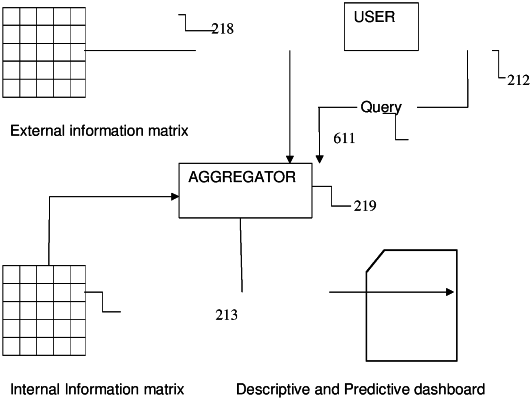| CPC G06Q 50/184 (2013.01) [G06F 7/02 (2013.01); G06F 16/24558 (2019.01); G06F 16/9535 (2019.01); G06Q 10/063 (2013.01); G06Q 30/0202 (2013.01); G06F 2216/03 (2013.01)] | 14 Claims |

|
1. A hardware processor implemented method for generating strategic competitive intelligence data relevant for an entity, the method comprising:
storing, in an internal portfolio database, internal intellectual property data of the entity;
receiving, by a data mining module, technology development data from one or more predefined sources and intellectual property data from the internal portfolio database;
storing, in an entity rule database, a set of rules relevant for the entity, wherein the set of rules are generated in real-time to identify and retrieve only relevant content from the predefined sources;
executing, by a rule engine, the set of rules;
filtering, by the data mining module, the technology development data and the intellectual property data, based on, the set of rules executed by the rule engine;
automatically populating, in at least one entity aligned cluster database, the filtered technology development data and the filtered intellectual property data, wherein each entity aligned cluster database corresponds to a predefined entity aligned cluster, wherein each entity aligned cluster database includes multiple tables for capturing data pertaining to a particular entity aligned cluster, wherein each entity aligned cluster is customizable according to an entity requirement and hybridized by including both technology and business data, wherein each entity aligned cluster database consists of predefined matrices with dimensions and measures as data fields, wherein the filtered technology development data and the filtered intellectual property data is segregated into the measures and attributes, and wherein the filtered technology development data and the filtered intellectual property data are categorized into particular entity aligned clusters depending on the segregation and predefined keywords associated with the entity aligned clusters as configured in a rule database;
executing, by a query engine, an input search query received from a user, wherein the query engine incorporates a self-learning capability to store relevant content from past usages and a self-improving capability to improve execution of the input search query over time, wherein the query engine employs a query knowledge database for utilizing past experience for the self-learning capability, and wherein the query knowledge database is a component of the self-learning capability to store relevant data, wherein the query search engine conducts a search, based on the set of rules, by:
a first level of search restriction by implementing one of whitelist of websites to search and blacklist of websites to ignore search;
filtration of entity aligned clusters based on context matching to identity at least one relevant entity aligned cluster for executing the input search query, wherein the context matching is achieved by matching a context stored in the rule database to text of the input search query, wherein the context is matched to the text by word matching and combination and sequence matching, wherein a scoring process is utilized in context matching to determine a strength of the context matching and to identify a relevant entity aligned cluster in context of the input search query, wherein the combination and sequence matching is performed by detecting each combination of words as they appear in the rule database and capturing occurrence of detection of each combination of words in the scoring process, and wherein the word matching is performed by detecting each word match in the rule database and capturing a word match count in the scoring process;
a second level of search performed only in the identified at least one relevant entity aligned cluster, based on keywords, to reduce a search throughput time;
populating, by an aggregator, relevancy scores in a first matrix specific to internal intellectual property data (PORTD matrix) and a second matrix specific to technology development data (EXTD matrix), based on output of said query engine, for each unique data set in a predetermined entity aligned cluster database;
aggregating, by the aggregator, the relevancy scores using the EXTD matrix and the PORTD matrix and generating output data (AGGD matrix), wherein each cell in the AGGD matrix includes an aggregate score by combining a relevancy score from the EXTD matrix and relevancy score from the PORTD matrix;
analyzing, by an analytics engine, the AGGD matrix based on the set of rules, wherein output of the analytics engine is data describing the output data of the aggregator and predicting strategic competitive intelligence data relevant for the entity, wherein the data describing the output data is derived from the analysis upon comparing the aggregated scores with a dynamically generated cut off score, wherein each cell in the AGGD matrix with an aggregate score higher than the dynamically generated cutoff score is selected for the data describing the output data, wherein the strategic competitive intelligence data relevant for the entity is predicted by a trend analysis of technology development data and internal intellectual property data by performing extrapolative analysis over a predefined and configurable period of time gathered backwards in time from a current time of the input search query, wherein the extrapolative analysis involves temporal prediction over the future and spatial prediction is used as an extension to the temporal prediction; and
displaying, by a display unit, the output of the analytics engine.
|